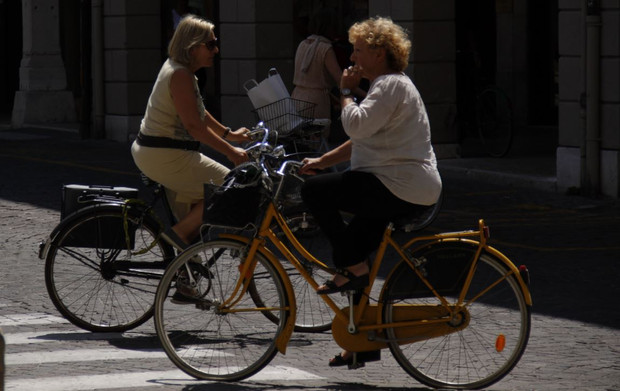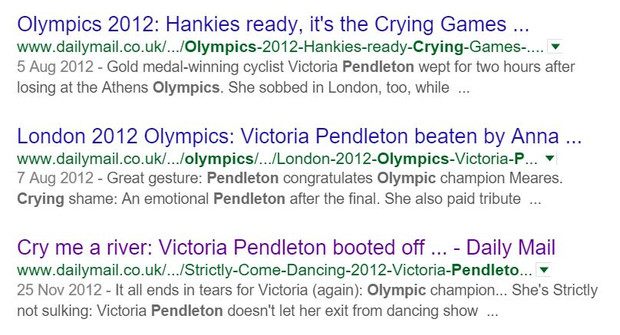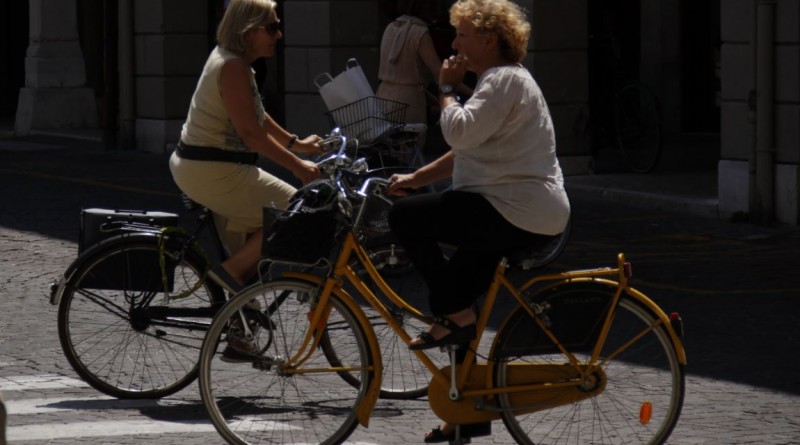Low Five – How Cycling Media Fails At Gender Equality
I was recently a panelist at the London Bike Kitchen ’s Women and Gender-variant night at Look Mum No Hands. The topic of the event was an examination of how women are portrayed in the world of cycling, both in marketing and media. It’s the second WAG event I’ve done with LBK, and in short order they have become some of my favourite speaking gigs. They are always packed, the topics are always significant and important, and the crowd is full of enthusiasm and a desire to genuinely make cycling better for all.
As I was putting my thoughts together about the subject, I thought I’d do a little research. I looked up some things about women in mass media to see if there are any parallels to cycling. I also wanted to see if there was any pattern or consistency to how we see women in the world of cycling, and specifically if there existed any areas that didn’t equally showcase men. It should come as no surprise that I had no trouble finding several ways in which cycling media pigeonholes women, and this is most likely a result of the way women are depicted in mainstream media publications.
As a preamble, it’s pretty safe to say that race coverage and inspirational stories are the two ways in which women and men are both featured. That being said, there is still a significant disparity in the amount of recognition received by women who race, or have great stories to tell. An examination of images and stories outside of those two areas reveals that there are essentially five ways in which women are depicted in marketing and media, with next to no parity for men.

Objectification
While Page 3 has been a staple of UK tabloids for decades, there are significant campaigns aimed at sending this inclusion back to the ‘70s. One doesn’t have to look very far to see that this sort of ‘barely dressed’ image of women is still alive and well in cycling. It seems like every week something new comes up that leaves me, and many others, shaking our heads and wondering what mental giants still think it’s a good idea to use scantily clad women as a way to sell cycling products. Whether it’s Assos, Maxxis, 661, Save Our Soles, Supacaz, or many others, the objectification of women by these brands suggests that these companies feel cycling is still the domain of men.
These examples happen with such regularity that it begs the question why marketing and ad departments seem to be so reluctant to shed the way of the caveman. The answer is pretty simple: the cycling industry is still a male-dominated trade. Most marketing departments don’t have the benefit of including women who can point out the egregious nature of campaigns that feature us wearing not much at all, and we don’t exist in enough numbers to be able to universally direct how we market to, and with women.
Appearance obsessed
In mainstream media, we are constantly being bombarded with examples of women who are ‘too’ something. Too old. Too fat. Too thin. Too frumpy. The list goes on. How this exists in cycling is a bit less obvious, since cycling doesn’t have an equivalent of OK magazine, really. However, with things like Cyclepassion calendars and podium girls, the notion that how a woman looks determines coverage most assuredly exists. Not too long ago, while I was working with a counterpart on the continent, I was attempting to get a UK rider on a team based in Germany. My rider met all the criteria: general bad ass, great kid, loves cycling, great brand ambassador, and also happened to be extremely good at riding a bike. Despite all of that, the question that I was asked first is if she was pretty, because ‘face value’ was an important part of the marketing strategy for the team.
“He’s not good looking enough to race on our downhill team.” said no one, ever.
Victims not achievers
News publications love to showcase the bad things that happen to women, rather than the myriad of ways that women absolutely rock. This isn’t to suggest that we never see stories of great achievement by women, but the numbers of these pale in comparison to how often we see women as victims. There’s also a correlation with the above category, when we see ‘poor celebrity X’ in her struggle to lose that baby fat, while ignoring the fact that perhaps she just won her second Oscar.
Cycling isn’t immune to highlighting women in unfavourable circumstances. The most recent example of this is how Sanne Cant has been photographed at the last two Cross World Championships. She’s narrowly missed winning Worlds two years in a row, and on the podium she had the audacity to look disappointed. She’s been absolutely flamed for her expressions, while people seem to forget how great she is at racing. And let’s not forget Victoria Pendleton being labelled an emotional wreck after crying on the podium at the 2012 Olympics. If you’re Paul Gascoigne in the 1990 World Cup though, crying makes you a national hero. Mark Cavendish is one of the best podium cryers of our time, but rather than criticism, it’s a showing of praise for his efforts we see in most media.

Just not there
Invisibility is a major problem plaguing women in the cycling industry. Magazines will say that their reader polls show the readership is largely male. This isn’t a surprise, particularly since most of the content doesn’t include much for women, and many product tests lack even a single women’s item.
Industry commentator Velocentric did a quick summary of Cycling Weekly magazine covers, and found that out of 52 issues, only 7 included an image of a woman. Of those, only 2 had women as the main image. This isn’t just limited to one publication, either, and I’m not suggesting that there aren’t stories about women in magazines, but again the amount of content is miniscule.
Magazines that have been aimed specifically at women tend to be short lived, probably because they try to include too much in a sport that consists of a huge amount of variety. Websites often consider the idea of having a women’s only version, but typically want the industry to shell out for advertising before the product is even seen. As someone put it to me recently, that’s like trying to sell someone one a never-before-seen car before allowing them to see it, or take a test drive.
The solution in my mind is not for publishers to start printing cycling magazines just for women. It’s to start including a more balanced offering in existing titles. Where brands and publishers do get this right is online, if for no other reason than it’s easy to incorporate a variety of content across numerous types of riders and riding.
Unconscious bias has also revealed itself in the form show speakers. At the recent Rouleur Classic, and the 2016 London Bike Show, the stage schedule had a notable lack of women. While it’s true that the attendees at cycling shows tend to be mostly male, I fail to understand why people in media positions don’t recognise that pro women, and women who have inspirational stories would appeal just as much to men. Plenty of men watch women’s racing on TV (when it’s on), just like plenty of men watch the women’s final of Wimbledon, and plenty of women watch Match of the Day.
 The main issue with not including women in marketing and media campaigns is that it limits the growth of the very sport that these publications cover. Anyone who looks at stats knows that women hold the key to the long term future of cycling, and our numbers grow every year. By not showing us any version of ourselves in various media formats, it again sends a message that cycling doesn’t want us. It’s a mistake to think that the growth of cycling is going to come from MAMILs and MAMBAs.
The main issue with not including women in marketing and media campaigns is that it limits the growth of the very sport that these publications cover. Anyone who looks at stats knows that women hold the key to the long term future of cycling, and our numbers grow every year. By not showing us any version of ourselves in various media formats, it again sends a message that cycling doesn’t want us. It’s a mistake to think that the growth of cycling is going to come from MAMILs and MAMBAs.When you combine ‘victims not achievers’ with invisibility, you find examples of how the achievements women are overlooked entirely. Last year, Pauline Ferrand-Prevot won the World Championships in THREE different cycling disciplines. Yet, the French magazine Velo, which awards the Velo d’Or, gave the award to Jerome Pinaut. Who? Even British Cycling isn’t immune to this, when it comes to publishing news stories from races. Helen Wyman is a great example of this. Last year she was filing her own race reports when BC simply left her out of coverage.
Wives and mothers
If there’s a silver lining to any of this, it might be that cycling media has yet to include us in a category in which mainstream media and marketing loves to put us. So far, cycling publications haven’t suggested that our success comes despite the fact that we are married with two kids and a dog.
I’m sure you’ve heard it, right? If not, the best example is the infamous Tweet from the official account of England football, the day after England took third in the World Cup: “Our #Lionesses go back to being mothers, partners, and daughters today…”
The double whammy of this is not only that it’s blatantly sexist and wouldn’t be said of the men’s team, but also the underlying fact that players on the England women’s team don’t get paid, and have to have second jobs in order to put food on the table. Ouch.
I’ve yet to see a similar example of this type of story hit the world of cycling, and I genuinely hope it stays that way.
So What?
The main issue with the five negative characterisations of women in media is that, at a minimum, it is a clear example of lack of empathy and unconscious bias. Both of these things are bad for the sport, in that they create barriers to getting more women and families into cycling for the long term. Visual imagery featuring women as objects sends discouraging messages to kids. For girls, it’s that cycling isn’t a sport for you to participate in, rather it’s a sport in which you are merely there to be eye candy. And for boys, it suggests that women and girls don’t belong in a man’s sport, and that their place within the industry is to attract you to various products.
Objectifying women in cycling media also brings out the worst among riders when it comes to comments. The nescient replies are often full of misogyny, either in simple terms such as ‘I would’, or in much worse cases where women are shouted down for expressing an opinion. One only needs to read of the experience of Amanda Batty , and how she was treated by both staff and readers of Pinkbike. If you want to challenge your own ability to empathise, have a read of her blog:
So what can you do? The biggest way to affect change in this arena, is to not stay silent. People who own bike stores have a voice, and vendors will listen. If you find a company’s marketing campaign to be against the ethos of your store, say so. If a product is branded in a way that makes you question whether or not it would make all cyclist feel welcome, then don’t stock it, and let the manufacturer know. And be proactive. Tell your suppliers that you want to see more marketing efforts that reflect the diverse nature of the sport. Don’t simply let them dictate to you what must go on your floors at the point of sale. The status quo for women won’t change until more men in the industry speak up on our behalf, and hold brands accountable for the way women are portrayed in cycling.
Gratitude to @Velocentric and @Velocast for research contributions




